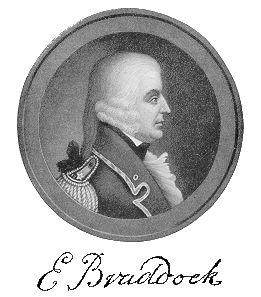
"...Thus died a man, whose good and bad qualities were intimately blended. " - George WashingtonQuietly it stands, a single marker, a reminder of a quest for empire that took place more than 200 years ago. The marker memorializes the final resting place of British Major General Edward Braddock, leader of an ill-fated expedition to the forks of the Ohio River to try to capture French-held Fort Duquesne. 
General BraddockAfter George Washington’s defeat at Fort Necessity, his British force retreated to Williamsburg. The French used British retreat to their advantage, and soon French-inspired Indian attacks occurred throughout the frontier. Terrorized settlers streamed eastward. The Braddock RoadThe overall British plan for 1755 was to simultaneously attack many French forts in North America. Braddock would lead the expedition against Fort Duquesne personally. That spring, he disembarked his army at Alexandria, Virginia. After augmenting his force with colonial militia and a few Indians, Braddock had about 2,400 men. Among the men was George Washington, a volunteer aide to the general. Battle of the MonongahelaIn early July, the advance group was approaching the forks of the Ohio. On July 9, a second crossing of the Monongahela River was made. From that point, it was a short march to Fort Duquesne. 
anniversary commemoration. NPS/250 Anniversary The General Is BuriedThe British camped near Braddock's Grave on July 13, and in the evening Braddock died. Washington officiated at the ceremony the next day, and the general was buried in the road his men had built. The army then marched, over the grave to obliterate any traces of it and continued to eastern Pennsylvania. Braddock's Grave - The Untold StoryAfter the French and Indian War ended, the Braddock Road remained a main road in this area. In 1804, some workmen discovered human remains in the road near where Braddock was supposed to have been buried. Officer's uniform buttons reportedly found at the site indicated that the remains were those of General Braddock. Initially, some of the remains were kept as souvenirs. Andrew Stewart, a local magistrate, learned of the desecration of the grave site and ordered the return of the remains. Reportedly, some hand bones found their way to the Peale Museum in Philadelphia. P.T. Barnum purchased the contents of the museum and moved it to New York City. A fire in 1864 destroyed the museum. In addition, a section of vertebrae is reportedly in the Walter Reed Hospital collection in Bethesda, Maryland. The remains that were recovered were then re-interred on a small knoll adjacent to the road. In 1913 the marker was placed where it is today, keeping its silent watch. The National Park Service preserves special places saved by the American people so all may experince our heritage. While visiting Braddock Grave, please park in designated areas and remain on exsiting trails and outside of fenced areas.
|
Last updated: May 15, 2024
